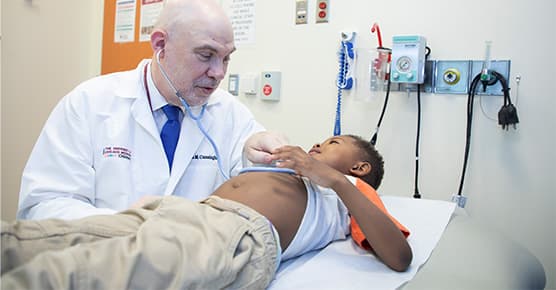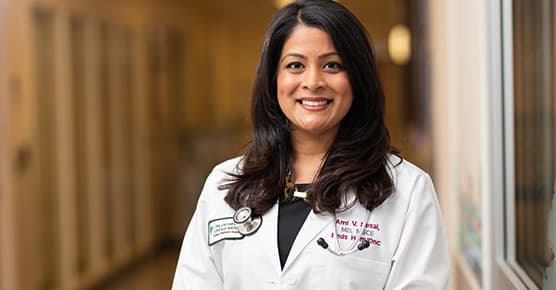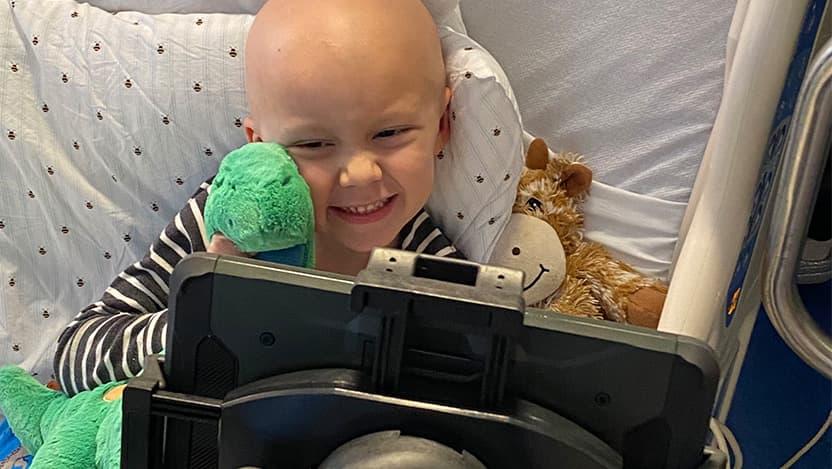Pediatric Cancer Surgery
Surgery often plays an integral role in treating most childhood cancers. Whether it's removing a tumor, supporting non-surgical treatment such as chemotherapy, or performing reconstructive surgery, the pediatric surgery team at the University of Chicago Medicine Comer Children's Hospital is involved in the comprehensive care that each child receives here.
Cancer can develop virtually anywhere in the body, from the head to the chest and abdomen to the bones. Common or rare, pediatric surgeons and other cancer specialists at Comer Children's have the experience and expertise to address them all.
Surgery's Role in Cancer Treatment
The surgeon's role varies in pediatric cancer care. Sometimes, the surgeons perform surgery and other times they don't — yet still may be involved in your child's care. At Comer Children's, all children benefit from the teamwork of various physicians, as well as other members of the pediatric cancer care team.
Here is a look at some of the common ways that pediatric surgeons may be a part of your child's cancer care:
Just because minimally invasive is newer doesn't always mean it's the best option for every child. Our surgeons are skilled in the full spectrum of surgical options, from minimally invasive to traditional open surgery. We recommend the approach that best meets each child's needs.
The pediatric surgeons at Comer Children's are recognized worldwide as leaders in using minimally invasive surgical techniques to treat a variety of conditions in children, including some cancers. Because it uses much smaller incisions than traditional surgery, minimally invasive methods usually mean less pain, easier recovery, less scarring or disfigurement and more normal growth after surgery. Whenever possible, surgeons here prefer minimally invasive surgery to remove solid tumors located virtually anywhere in the child's body.
If surgery is recommended (minimally invasive or traditional surgery), it often is one component of a multi-dimensional approach to eliminating cancer. For example, surgery to remove a tumor in the kidney may be followed with chemotherapy to destroy remaining cancer cells. Or, our team may use radiation therapy to shrink a tumor in the brain or bones before surgery. It's all part of our collaborative, comprehensive approach to treating childhood cancers.
Comer Children's pediatric neurosurgeons use minimally invasive techniques to reach tumors that may be deep within the brain or within the spine, including tumors that cannot be reached by traditional surgery. Stereotactic imaging and other very detailed imaging technologies reveal the exact location and dimensions of the tumor, so the neurosurgeon can be very precise in removing only cancerous tissue and protecting healthy tissue. We treat the full range of brain-related tumors, including neurofibromatosis, eye tumors and other conditions.
Surgery to remove tumors is the standard treatment for bone cancer (osteosarcoma). At Comer Children's, we use innovative techniques to avoid amputation. More than 20 years ago, this was one of the first hospitals offering less radical limb-salvage methods as an alternative to amputation.
Today, our pediatric orthopaedic surgeons are among the first in the U.S. performing articular-sparing surgery — a refinement of the limb-salvage technique. This newest technique preserves as much of the child's own bone or joint as possible. Cadaver bone and tissue is then fitted to the child's natural bone like puzzle pieces — resulting in a joint or limb that is even stronger and remains more stable as the child grows, and giving kids a better chance to be active after cancer surgery.
Articular-Sparing Surgery for Osteosarcoma (Bone Cancer)
UChicago Medicine general and thoracic surgeons may be called in to address bone cancer that has spread to the lung (metastatic lung disease). These skilled surgeons carefully remove affected tissue while preserving the child's lung function.
Leukemia (a bone marrow- and blood-related malignancy) is the most common type of cancer among children. There are several different types of leukemia which, together, account for about one-third of all childhood cancers. Lymphomas are related, but not as common in children. Neither leukemias nor lymphomas have "solid" tumors that can be removed surgically. Nonetheless, pediatric surgeons often participate in the care of children with these conditions by placing central lines (venous access device) that make it more comfortable for kids to get repeated chemotherapy treatments and for doctors to take biopsies.
Dedicated Care Team Supports Each Patient's Recovery
Children's cancer care is truly a team effort at Comer Children's, and pediatric surgeons are just one component of the team. There are many people focused on helping children and families challenged by pediatric cancer. These include:
The surgeons work with many other pediatric physicians at Comer Children's to address childhood cancers. Pediatric medical oncologists, pediatric radiation oncologists and pediatric neuroradiologists also are essential members of the cancer team. Other physicians who may be involved in your child's care include: neurologists specializing in neurofibromatosis or tuberous sclerosis, nephrologists (kidney), hepatologists (liver), pathologists, neuropathologists and many others.
Teamwork makes things work smoothly. Physicians and surgeons involved in cancer care meet formally each week for our Weekly Pediatric Tumor Board to discuss the best options for each child's treatment. These conferences provide a forum for multiple perspectives and broad insights. Nurses and other members of the care team sometimes also participate in these conferences. In addition to the weekly conferences, our team members meet informally on a daily basis to talk about each child's care and progress.
Nurse practitioners are advanced practice nurses who work with each family affected by childhood cancer. The nurse practitioner serves as a central contact person for the family, and is a bridge between the child and family and the many physicians, nurses, technicians and non-medical staff who participate in your child's care. The nurse practitioner also is a good person to go to with questions, for explanations, or when the physicians cannot be reached right away. (Parents and children also can contact their physicians directly, but sometimes it may be easier to reach the nurse practitioner.)
Pediatric nurses work with children who are staying in the hospital, and with those who come back for checkups with the care team.
Rehabilitation specialists, speech therapists, physical therapists and others provide ongoing support as your child recovers and regains function.
Social workers address a wide array of non-medical needs related to your child's care in the hospital and after he or she returns home.
Child life specialists focus on helping children be kids, in spite of their illness or treatment. They use play therapy, workshops with your child's school and other activities that help pediatric patients feel better about themselves, help them understand their illness and procedures, lessen the scariness or loneliness that kids sometimes feel in the hospital and to ease your child's transition back to school.
Radiation technicians, surgical technicians and other allied health professionals assist with many diagnostic tests and treatment procedures.








